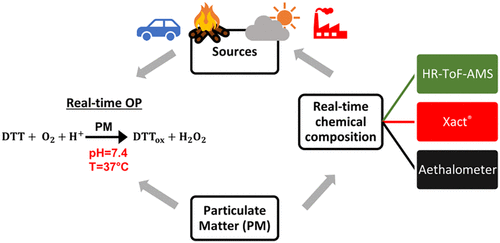当前位置:
X-MOL 学术
›
Environ. Sci. Technol. Lett.
›
论文详情
Our official English website, www.x-mol.net, welcomes your feedback! (Note: you will need to create a separate account there.)
Real-Time Measurements of PM2.5 Oxidative Potential Using a Dithiothreitol Assay in Delhi, India
Environmental Science & Technology Letters ( IF 10.9 ) Pub Date : 2020-05-18 , DOI: 10.1021/acs.estlett.0c00342 Joseph V. Puthussery 1 , Atinderpal Singh 2 , Pragati Rai 3 , Deepika Bhattu 3 , Varun Kumar 3 , Pawan Vats 4 , Markus Furger 3 , Neeraj Rastogi 2 , Jay G. Slowik 3 , Dilip Ganguly 4 , Andre S. H. Prevot 3 , Sachchida Nand Tripathi 5 , Vishal Verma 1
Environmental Science & Technology Letters ( IF 10.9 ) Pub Date : 2020-05-18 , DOI: 10.1021/acs.estlett.0c00342 Joseph V. Puthussery 1 , Atinderpal Singh 2 , Pragati Rai 3 , Deepika Bhattu 3 , Varun Kumar 3 , Pawan Vats 4 , Markus Furger 3 , Neeraj Rastogi 2 , Jay G. Slowik 3 , Dilip Ganguly 4 , Andre S. H. Prevot 3 , Sachchida Nand Tripathi 5 , Vishal Verma 1
Affiliation

|
The oxidative potential (OP) of ambient particulate matter (PM) is a metric commonly used to link the aerosol exposure to its adverse health effects. In this study, we report the first-ever real-time measurements of ambient PM2.5 OP based on a dithiothreitol (DTT) assay in Delhi, during a late winter season (February 2019). The chemical composition of PM was also measured using various collocated online instruments to identify the chemical components driving the PM2.5 OP. The hourly averaged OP during the entire campaign ranged from 0.49 to 3.60 nmol min–1 m–3, with an average value of 1.57 ± 0.7 nmol min–1 m–3. The secondary organic aerosols appear to be the major driver for the variation in the intrinsic OP of PM2.5. Although the average PM1 mass concentration at Delhi was 13 times the average PM2.5 mass concentration reported in Illinois, USA, in a similar study, it was not accompanied by a proportionate increase in the OP (the average volume-normalized DTT activity of PM2.5 was only 5 times that reported in Illinois). These findings reveal substantial spatial heterogeneity in the redox properties of PM and highlight the importance of determining the PM chemical composition along with its mass concentrations for predicting the overall health impacts associated with aerosol exposure.
中文翻译:

在印度德里使用二硫苏糖醇测定法实时测量PM 2.5氧化电位
环境颗粒物(PM)的氧化电位(OP)是通常用于将气雾剂暴露与其有害健康影响联系起来的度量标准。在这项研究中,我们报告了在冬季后期(2019年2月)在德里进行的基于二硫苏糖醇(DTT)分析的首次实时环境PM 2.5 OP实时测量。还使用各种并置的在线仪器测量了PM的化学成分,以识别驱动PM 2.5 OP的化学成分。在整个活动中,每小时平均OP范围为0.49至3.60 nmol min –1 m –3,平均值为1.57±0.7 nmol min –1 m –3。次级有机气溶胶似乎是导致PM 2.5内在OP变化的主要驱动力。尽管在德里的平均PM 1质量浓度是美国伊利诺伊州报告的平均PM 2.5质量浓度的13倍,但在类似的研究中,并没有伴随着OP的按比例增加(PM的平均体积归一化DTT活性2.5仅为伊利诺伊州报告的5倍)。这些发现揭示了PM氧化还原特性中的实质性空间异质性,并强调了确定PM化学成分及其质量浓度对预测与气溶胶暴露有关的整体健康影响的重要性。
更新日期:2020-07-14
中文翻译:

在印度德里使用二硫苏糖醇测定法实时测量PM 2.5氧化电位
环境颗粒物(PM)的氧化电位(OP)是通常用于将气雾剂暴露与其有害健康影响联系起来的度量标准。在这项研究中,我们报告了在冬季后期(2019年2月)在德里进行的基于二硫苏糖醇(DTT)分析的首次实时环境PM 2.5 OP实时测量。还使用各种并置的在线仪器测量了PM的化学成分,以识别驱动PM 2.5 OP的化学成分。在整个活动中,每小时平均OP范围为0.49至3.60 nmol min –1 m –3,平均值为1.57±0.7 nmol min –1 m –3。次级有机气溶胶似乎是导致PM 2.5内在OP变化的主要驱动力。尽管在德里的平均PM 1质量浓度是美国伊利诺伊州报告的平均PM 2.5质量浓度的13倍,但在类似的研究中,并没有伴随着OP的按比例增加(PM的平均体积归一化DTT活性2.5仅为伊利诺伊州报告的5倍)。这些发现揭示了PM氧化还原特性中的实质性空间异质性,并强调了确定PM化学成分及其质量浓度对预测与气溶胶暴露有关的整体健康影响的重要性。



























 京公网安备 11010802027423号
京公网安备 11010802027423号